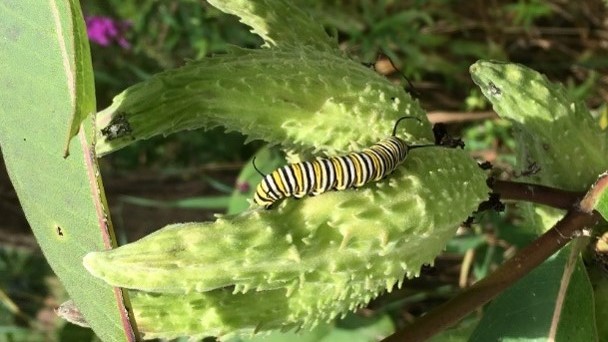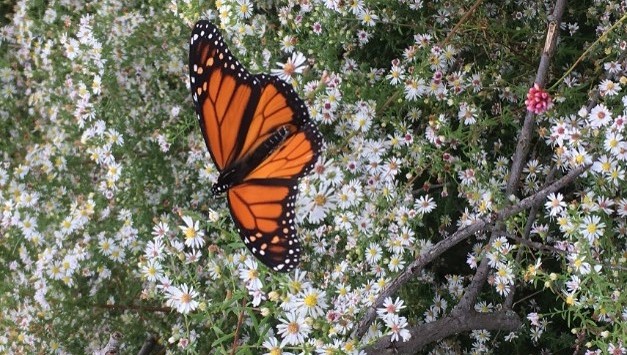The Plight of the Pollinator -- Pollinators and Rights-of-Way
Posted June 13, 2022
Many people are familiar with the plight of the polar bear due to climate change. However, worldwide declining populations of pollinators are also gaining more recognition. Besides honeybees, hummingbirds, and butterflies, pollinators include flies, bats, moths, beetles, wasps, and other bees. Their declining numbers are concerning since pollinators play a key role in plant reproduction providing humans with food sources, medicinal ingredients, and building materials.
The global decline in pollinator populations is attributed to habitat loss/fragmentation, climate change, pesticide use, and the spread of emergent pathogens, predators, and parasites. In the US, beekeepers have lost approximately 30% of their colonies every year since 2006 (Penn State Department of Entomology). Eastern monarch butterfly (Danaus plexippus) populations have decreased from an estimated 383 million to just under 45 million (88%) between 1996 and 2020, and western populations are also down (according to the US Fish and Wildlife Service (USFWS)).
Since many pollinator species have unique life histories and specific habitat needs, they are especially sensitive to disturbances. The monarch butterfly, which relies solely on milkweed (Asclepiadaceae spp.) for reproduction, is a prime example.
With climate change, growing and blooming seasons are shifting, and migration patterns are changing. In addition to these direct effects on pollinators, climate change indirectly affects these species. Other species that may act as predators, competition, or parasites may move into an area and negatively impact native pollinator populations.

The Importance of ROWs
With these stresses on pollinator populations, utility distribution and transmission right-of-way (ROW) networks become more suitable habitats for pollinators. They offer long linear habitat areas having low vegetation that are often minimally disturbed by humans, especially more rural ROWs, and can provide vital linkages between suitable non-ROW habitats. In the Albany Pine Bush area of New York State, transmission ROWs provide essential habitat for the Karner blue butterfly (Plebejus melissa samuelis), a state and federally-listed endangered species that requires wild blue lupine (Lupinus perennis) for survival. The sandy soil offered by the Albany Pine Bush area, coupled with the maintained low herbaceous vegetation on transmission ROWs, have promoted the wild blue lupine habitat and thus the Karner blue butterfly population on the ROW.
The fact that utility ROWs provide suitable habitat for many pollinators presents utilities with advantages and disadvantages. While utilities can claim that their ROWs help protect and promote pollinators, utilities will likely need to modify vegetation management styles along the ROWs to accommodate these pollinator populations. For instance, the monarch butterfly has been listed as a candidate species with the USFWS. Monarch caterpillars feed exclusively on milkweed, and milkweed grows in areas containing low herbaceous vegetation. Therefore, milkweed populations on ROWs will need to be treated with more sensitivity because of the upgraded status of the monarch butterfly. Vegetation management in the Albany Pine Bush requires a Conservation Management Plan and an incidental take permit from the USFWS with buy-in from the New York State Department of Environmental Conservation (NYSDEC) and Albany Pine Bush Preserve Commission (APBPC) for Karner blue butterflies because of their state and federal status.
Taking a Proactive Approach
Utilities can take proactive steps to protect pollinators while minimizing the impact on their practices. Vegetation mowing can be conducted during the off-season. Some species of pollinators migrate south in the winter (e.g., monarch butterflies); others overwinter in their nest or hive (e.g., honeybees). Utilities may also conduct habitat assessments or floral surveys along their ROWs to identify potentially sensitive areas and plan maintenance and construction activities appropriately. Utilities can take additional steps to enhance pollinator habitat, including using a pollinator flower/grass mix for soil stabilization. They can also convert lawns and grass areas around facilities into pollinator habitats reducing greenhouse gas emissions from mowing, and support community activism through floral and pollinator plant/seed giveaways or education.
Orange and Rockland Utilities, Inc. (O&R) has been enhancing pollinator habitats on their ROWs, substations, and other facilities since 2017; they currently have 17 active pollinator-enhanced habitats (O&R personal communication). Their habitats on transmission ROWs were enhanced during project restoration activities. As new transmission line projects come up, O&R staff survey the project area for potential pollinator habitats and work to minimize potential impacts. O&R continues to conduct routine ROW vegetation management on a 3-year cycle, maintaining low vegetation types while negligibly disturbing pollinators.

Conclusion
With the declining numbers of pollinators, utility ROWs may become more important pollinator habitats in the future. Thus, utilities may need to be more cognizant of the potential populations existing on their ROWs and be more sensitive to these populations when planning construction projects or routine vegetation management. Pollinator protection will likely become a more important issue as pollinator populations become more critical.
References
Penn State Department of Entomology. Disappearing Pollinators. Retrieved from https://ento.psu.edu/research/centers/pollinators/resources-and-outreach/disappearing-pollinators
National Park Service. Pollinators and Climate Change. Retrieved from https://www.nps.gov/articles/000/pollinators-climateimpact.htm
US Fish and Wildlife Service. Monarch Fact Sheet. Retrieved from https://www.fws.gov/initiative/pollinators/monarchs
About Orange and Rockland Utilities, Inc. (O&R)
Located in the northwestern suburbs of New York City, Orange & Rockland and its subsidiary, Rockland Electric Company, serve approximately 300,000 electric customers in New York and northern New Jersey and more than 130,000 natural gas customers in New York.